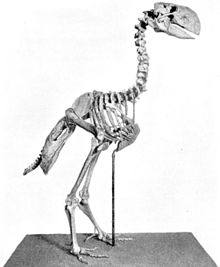
Fowl are birds belonging to one of two biological orders, namely the gamefowl or landfowl (Galliformes) and the waterfowl (Anseriformes). Anatomical and molecular similarities suggest these two groups are close evolutionary relatives; together, they form the fowl clade which is scientifically known as Galloanserae or Galloanseres. This clade is also supported by morphological and DNA sequence data as well as retrotransposon presence/absence data.
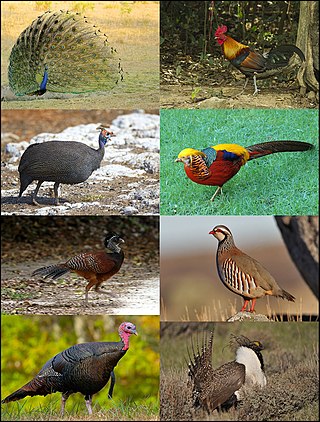
Galliformes is an order of heavy-bodied ground-feeding birds that includes turkeys, chickens, quail, and other landfowl. Gallinaceous birds, as they are called, are important in their ecosystems as seed dispersers and predators, and are often reared by humans for their meat and eggs, or hunted as game birds.

Anseriformes is an order of birds also known as waterfowl that comprises about 180 living species of birds in three families: Anhimidae, Anseranatidae, and Anatidae, the largest family, which includes over 170 species of waterfowl, among them the ducks, geese, and swans. Most modern species in the order are highly adapted for an aquatic existence at the water surface. With the exception of screamers, males have penises, a trait that has been lost in the Neoaves, the clade consisting of all other modern birds except the galliformes and paleognaths. Due to their aquatic nature, most species are web-footed.

Genyornis newtoni, also known as the Newton's mihirung, Newton's thunder bird, Giga-Goose or mihirung paringmal, is an extinct species of large, flightless bird that lived in Australia during the Pleistocene Epoch until around 50,000 years ago. Over two metres in height, they were likely herbivorous. Many other species of Australian megafauna became extinct in Australia around that time, coinciding with the arrival of humans. It is the last known member of the extinct flightless bird family Dromornithidae which had been part of the fauna of the Australian continent for over 30 million years. They are not closely related to ratites such as emus, and their closest living relatives are thought to be fowl.

Gastornis is an extinct genus of large, flightless birds that lived during the mid-Paleocene to mid-Eocene epochs of the Paleogene period. Most fossils have been found in Europe, and possible specimens are known in North America and Asia. Several genera including Diatryma were historically considered to be congeneric with Gastornis, but recent interpretations challenged this referral.

Dromornithidae, known as mihirungs and informally as thunder birds or demon ducks, were a clade of large, flightless Australian birds of the Oligocene through Pleistocene epochs. All are now extinct. They were long classified in Struthioniformes, but are now usually classified as galloanseres. Dromornithids were part of the Australian megafauna. One species, Dromornis stirtoni, was 3 m tall. Only a single species, Genyornis newtoni survived into the Late Pleistocene. They are thought to have been herbivorous.

Dromornis is a genus of large to enormous prehistoric birds native to Australia during the Oligocene to Pliocene epochs. The species were flightless, possessing greatly reduced wing structures but with large legs, similar to the modern ostrich or emu. They were likely to have been predominantly, if not exclusively, herbivorous browsers. The male of the largest species, Dromornis stirtoni, is a contender for the tallest and heaviest bird, and possibly exhibited aggressive territorial behaviour. They belong to the family Dromornithidae, extinct flightless birds known as mihirungs.
Ilbandornis was a genus of ostrich-sized dromornithid, a clade known casually as "demon ducks" because they are most closely related to the water fowl clade anseriformes. It was far more lightly built than other members of the family, indicating a more cursorial lifestyle; it was a fast runner. The majority of researchers consider Dromornithids to be herbivorous; this is borne out by molecular analysis of the gastroliths and eggshells of both Ilbandornis and the related Genyornis. While Ilbandornis and Genyornis have skulls of similar size to emus, other Dromornithids such as Dromornis have far more robust skulls with large beaks; these were previously considered an adaptation for carnivory, but their blunt edges and lack of hooked tip indicate that the species were herbivorous. It is therefore likely that the differences in skull shape are due to differences in diet. Ilbandornis went extinct sometime in the Miocene epoch.
Barawertornis tedfordi was a dromornithid (mihirung), a large flightless fowl hailing from Late Oligocene to Early Miocene. The only species in the genus Barawertornis, its fossil remains are found in strata of the Riversleigh deposits located at two sites in Northwestern Queensland, Australia.
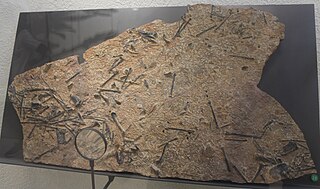
Presbyornis is an extinct genus of presbyornithid bird from North America during the Paleogene period, between the Late Paleocene and Early Eocene.

Sylviornithidae is an extinct family of flightless birds, known from subfossil bones found in Holocene aged deposits on the Melanesian islands of New Caledonia and Fiji. For many years it was considered a monotypic family consisting of the New Calendonia Sylviornis alone, but recent studies show that the Fijian Megavitiornis was part of this clade as well. Long considered to have galliform affinities, a 2016 study suggested that they were outside the Galliformes crown group, while a 2024 study suggested that they were members of the Galliformes crown group as more closely related to Phasianoidea than to Megapodiidae, and were most closely related to the extinct giant gastornithids.

Brontornis is an extinct genus of giant bird that inhabited Argentina during the Early to Middle Miocene. Its taxonomic position is highly controversial, with authors alternatively considering it to be a cariamiform, typically a phorusrhacid or an anserimorph.
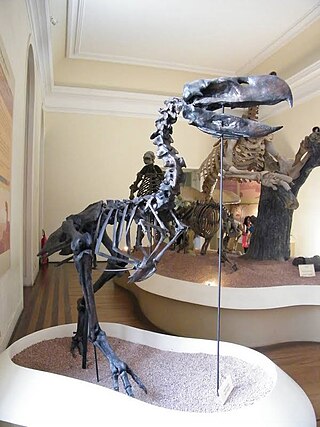
Paraphysornis is an extinct genus of giant flightless terror birds that inhabited Brazil during Late Oligocene or Early Miocene epochs. Although not the tallest phorusrhacid, Paraphysornis measured up to 1.4 metres tall at the hips and weighed around 180–240 kilograms (400–530 lb). It was also a notably robust bird, having short and robust tarsal bones not suited for pursuit hunting.
Physornis is an extinct genus of giant flightless predatory birds of the family Phorusrhacidae or "terror birds", most closely related to Paraphysornis, that lived in Argentina. The type species is P. fortis. It lived during the Middle to Late Oligocene (Deseadan). Few fossils are known, but the available material suggests that Physornis was one of the largest phorusrhacids.
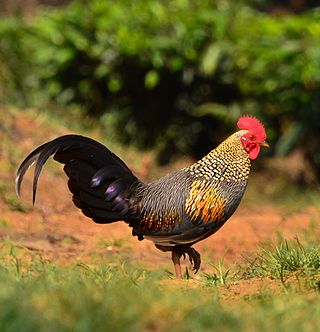
Pangalliformes is the scientific name of a provisional clade of birds within the group Galloanserae. It is defined as all birds more closely related to chickens than to ducks, and includes all modern chickens, turkeys, pheasants, and megapodes, as well as extinct species that do not fall within the crown group Galliformes.
Bradley Curtis Livezey was an American ornithologist with scores of publications. His main research included the evolution of flightless birds, the systematics of birds, and the ecology and behaviour of steamer ducks.
Wilaru is an extinct genus of presbyornithid bird from Australia during the Late Oligocene to Early Miocene, around 26-22 million years ago. The type species is Wilaru tedfordi, and the second species is Wilaru prideauxi.

The Odontoanserae is a proposed clade that includes the family Pelagornithidae and the clade Anserimorphae. The placement of the pseudo-toothed birds in the evolutionary tree of birds has been problematic, with some supporting the placement of them near the orders Procellariformes and Pelecaniformes based on features in the sternum.
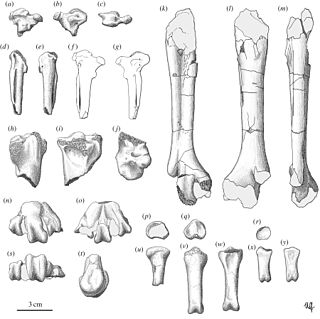
Garganornis is an extinct genus of enormous flightless anatid waterfowl from the Late Miocene of Gargano, Italy. The genus contains one species, G. ballmanni, named by Meijer in 2014. Its enormous size is thought to have been an adaptation to living in exposed, open areas with no terrestrial predators, and as a deterrent to the indigenous aerial predators like the eagle Garganoaetus and the giant barn owl Tyto gigantea.

Vegaviidae is an extinct family of birds of uncertain phylogenetic placement, which existed during the Late Cretaceous and possibly the Paleocene. Definitive fossils attributed to the family have only been found in Antarctica, though other fossils from the Southern Hemisphere including Chile and New Zealand may represent this group. The putative Campanian vegaviid from Canada known as Maaqwi, more likely belongs to the Procellariformes.
